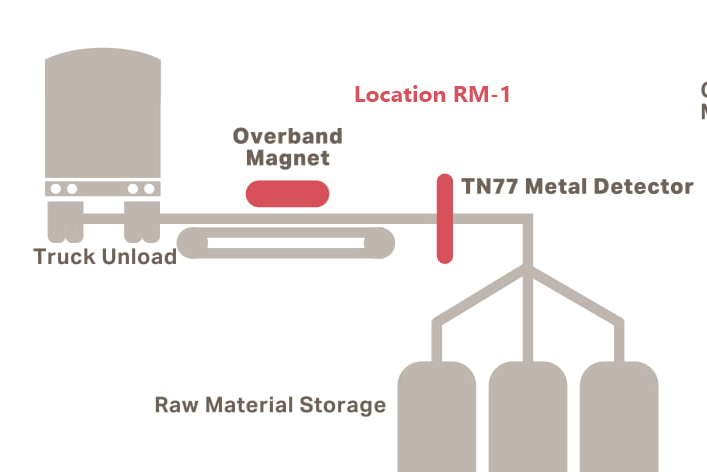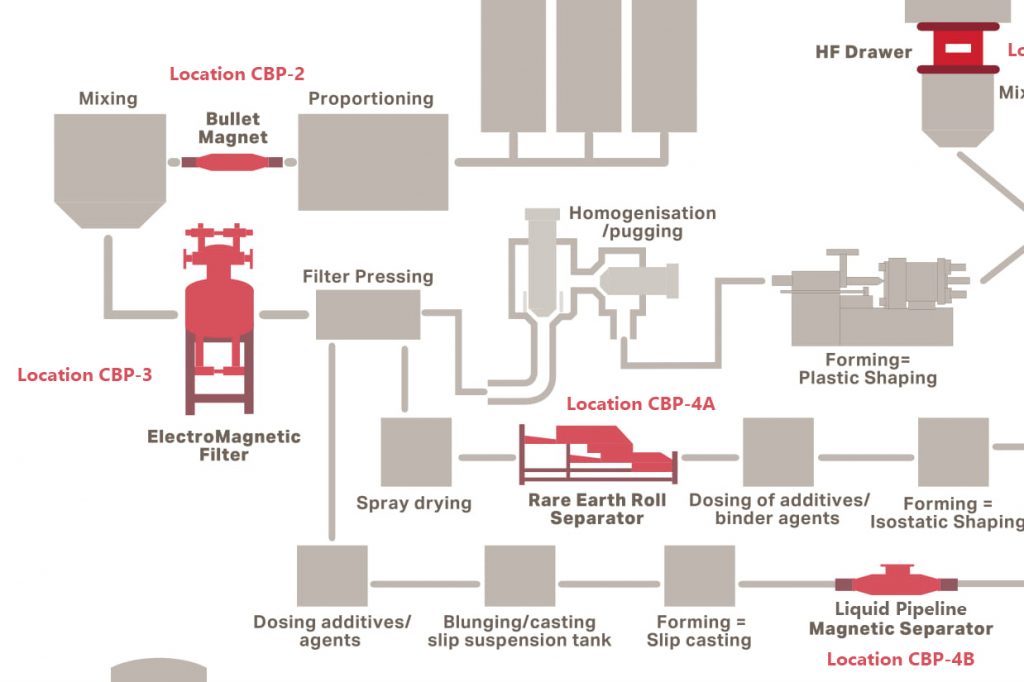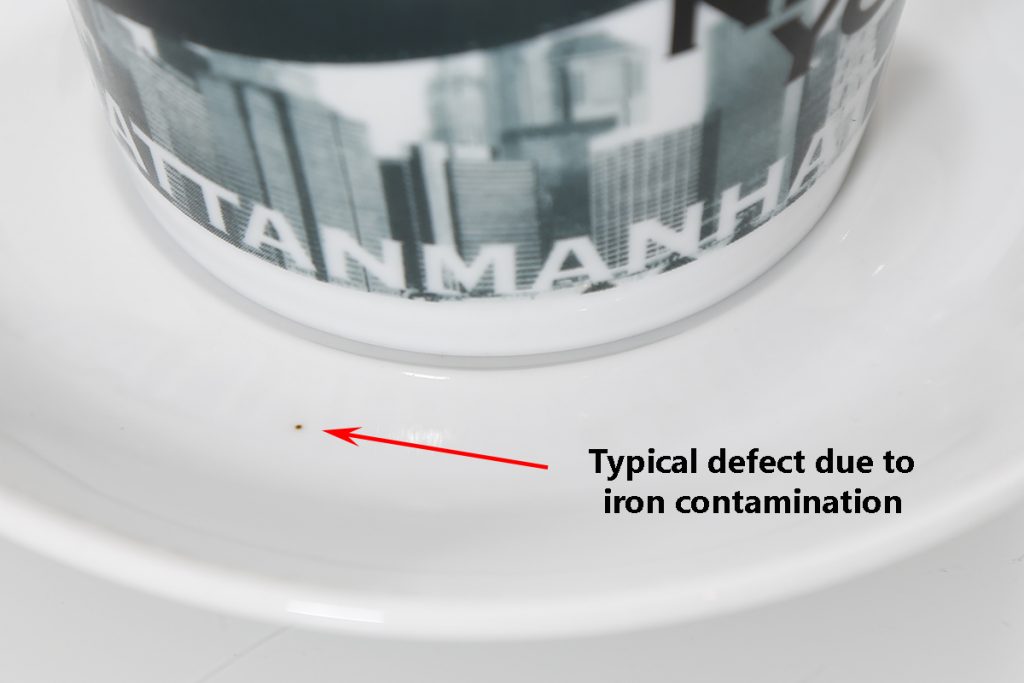Keeping Ceramic Tableware Iron Blemish Free
By Paul Fears | 08 June 2020
Fine iron and iron-bearing minerals cause visual and structural defects in ceramic tableware. Such contamination appears as small dark spots on the surface or is hidden within the body and causes premature cracking of the ceramic. The cup, saucer or plate is then either rejected or reworked.

Iron contamination
The problem of iron contamination is not new. The mix of minerals used to produce ceramics often include iron-bearing minerals (e.g. hematite and biotite mica). In the past, flaws such as iron spotting or discolouration, were masked by adding patterns and decals to the tableware. However, in more recent times, the high demand for plain white tableware means that any defect due to iron contamination is easily visible. Subsequently, reject and rework rates are high, which are costly in terms of time, production and wasted materials.
Iron-contamination problems are solvable thereby improving the cost effectiveness of manufacture. Many ceramic tableware manufacturers use a combination of different designs of magnetic separators located at key points within the production process. The magnetic separators attract and remove any magnetic particle before the ceramic is fired.

In this blog, we review a typical ceramic tableware plant and identify locations and magnetic separator designs to successfully remove iron from the process.
Location RM-1 – Raw Material Infeed

Raw materials such as feldspar, zircon sand, silica sand, calcium carbonate and various clays are commonly delivered by road on a truck. Although many raw material suppliers use magnetic separators and metal detectors to remove and detect metal, larger tramp metal contamination is often picked up in the truck, or during loading and discharge. A combination of a permanent Overband Magnet (Model PCB) and Metal Detector (Model TN77) on the main conveyor feeding the raw material storage silos ensures that all larger tramp metal, ferrous and non-ferrous (e.g. digger teeth, larger bolts and screws), is removed or detected. This prevents larger metal entering the process, where it would seriously damage processing equipment, such as screens and mills. Also, if the larger metal is not removed, it enters the process and gets broken down into a significantly large number of smaller particles, which spread throughout the raw material mix and are far more difficult to remove.
Ceramic Body Preparation
Removing fine iron and magnetic minerals reduces the risk of structural and surface defects in the tableware post-firing. When iron is exposed to high temperatures, the particles react compromising the structural integrity of the ceramic. Surface defects are also an issue, even though the un-fired tableware is coated in glaze. Iron particles can cause uneven surfaces and discolouration and, when large in size, can break through the thin glaze coating.

There are several key locations for magnetic separators in the ceramic body preparation process.
Location CBP-2 – Prior to Mixing
The dry raw materials are fed in designated proportions into a mixer. Potentially within the mix is smaller tramp magnetic metal such as washers, nails, rust, pipe-scale etc. At this point there are two recommended magnetic separators, depending on the specific installation:
- Option A – A permanent Bullet Magnet, featuring a strong rare earth magnet, fitted into the pipeline captures smaller tramp metal such as smaller nails, washers, etc prior to mixing. The metal is held to the centrally-located magnet, which is periodically manually cleaned;
- Option B – Drawer Filter Magnets, featuring one or more grids of strong rare-earth Tube Magnets, are often fitted to the base of silos or on the infeed to mixers. The material passes over the Tube Magnets, which attract and hold fine ferromagnetic particles. The Tube Magnets are either cleaned manually or automatically.
Location CBP-3 – After Mixing as a Body
The best location for removing fine iron and magnetic minerals is after the non-metallic minerals are mixed into a slurry state (the ceramic ‘body’). Due to the high volume of material, a larger and higher-intensity magnetic separator is recommended.

The Electro Magnetic Filter is an automatic self-cleaning magnetic separation system that is able to handle large throughputs. The Electro Magnetic Filter generates far higher magnetic fields than permanent magnets, increasing the efficiency of separating fine iron and weakly magnetic minerals. Additionally, the self-cleaning operation ensures that the maximum separation of magnetics is maintained at all times. A typical cleaning cycle would be every twenty minutes depending on the level of ferrous contamination in the feed.
This is often the final opportunity to capture and remove the magnetic contamination prior to the body moving onto the filter press.
Location CBP-4A – After Spray Drying
In some ceramic tableware plants, the body is dried into uniformly-sized small grains using a spray drier. Spray drying is a method of producing a dry powder from a liquid or slurry by rapidly drying with a hot gas. Very often fine iron is introduced into the process by the drier via the hot air supply resulting in contamination including iron sticking to some of the spray dried particles.
High-intensity permanent magnetic separators, such as the Rare Earth Roll Separator and the Rare Earth Drum Magnet, automatically and continuously removing any free iron and iron-contaminated spray dried particles.
- Option A – The Rare Earth Roll Separator consists of a conveyor with a high-intensity head roll constructed from permanent rare earth (neodymium) magnets. Spray dried ceramic is fed evenly onto the belt via a vibratory feeder and conveyed into the magnetic field of the rare earth roll. Magnetic particles, including spray dried ceramic with iron inclusions, are attracted and discarded underneath away from the clean product;
- Option B – A permanent Rare Earth Drum Magnet uses a stationary arc of magnets inside a rotating non-magnetic shell to attract, hold and separate magnetic particles. Spray dried ceramic is fed evenly via a vibratory feeder onto the top of the drum and into the magnetic field. As with the Rare Earth Roll Separator, magnetic particles, including spray dried ceramic with iron inclusions, are attracted and discarded underneath away from the clean product;
Location CBP-4B – Slip Prior to Pressing as a Biscuit
After filter pressing, some plants produce a slip. To ensure that the slip is iron-free after dosing, blunging and slip casting, a Liquid Pipeline Separator, designed with strong permanent Tube Magnets, is installed into the pipe. The Tube Magnets capture any introduced tramp iron. This is the final safety check point prior to forming as a biscuit and firing.
Glaze Preparation
The Glaze provides the perfect finish to any tableware, but can be compromised if contaminated with even the smallest specks of iron. During the firing process, the iron will react with the heat, causing spotting or discolouration of the glaze. Therefore, it is critical that the Glaze is iron-free.

The Glaze colour depends on the tableware design, but is commonly white. Care is needed when passing coloured Glaze through any magnetic separator as the pigments can have magnetic properties.

Location GP-2 – Prior to Mixing
The Glaze raw materials are delivered in the same way as those for the Body, and stored in designated silos. As with Body, after proportioning, the dry raw material mix passes through a permanent magnetic separator such as a Bullet Magnet or Drawer Magnet (both with high strength rare earth magnets) as they are fed into the mixer.
Location GP-3 – After Mixing as a Glaze
The critical point for high-intensity separation of fine iron and magnetic minerals is after the non-metallic raw materials are mixed into a wet state to form the glaze. Commonly, there will be a Glaze preparation area where different types and colours of Glazes are made and stored.
As with the Body, the optimum iron-separation system is the high-intensity Electro Magnetic Filter. Commonly, for Glaze operations, this operates on a batch-fed basis treating one container of Glaze at a time. Many Electro Magnetic Filters are mounted on moveable wheeled frames for easy re-positioning within a designated area, or even next to the Glazing Line. It is important to consider the consistency of the Glaze as this may affect the flowability, especially if containing a gluing agent.
The Electro Magnetic Filter removes fine iron and weakly magnetic minerals, reducing the risk of surface contamination and product rejects.
Location GP-4 At the Glaze Station
The Glaze is often transported in Glaze carts to Glazing Stations. At the station, high-strength Tube Magnets are positioned either inside a type of Liquid Pipeline Magnetic Separator or stand-alone in a design configured by the customer. Glaze will run across the surface of the Tube Magnets to remove any fine iron before being either poured or sprayed onto to tableware biscuit. Such protection provides a vital final stage protection against iron contamination prior to final firing.
Related Technical Articles
Optimum Magnetic Separation Reduces Rejects
Understanding the ceramic manufacturing process is important when making recommendations for the optimum magnetic separation equipment. The magnetic separators mentioned in this review are used successfully in ceramic production operations. However, each manufacturing process is unique and a visit by a local Bunting Sales Engineer will help understand a specific process and iron contamination issue and propose a specific solution.
For additional information on eradicating iron contamination blemishes in ceramic tableware, tiles, or sanitaryware, please contact us on:
Email: Gordon Kerr at GKerr@buntingmagnetics.com
Telephone: +44 (0) 1527 65858
Follow us on social media
